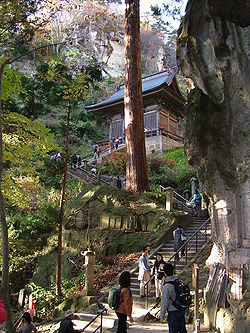
Yama-dera
Encyclopedia

Yamagata, Yamagata
is the capital city of Yamagata Prefecture in Japan.As of July 1, 2011, the city has an estimated population of 253,951 with 97,457 households and a population density of 665.94 persons per km². The total area is 381.34 km². The city was founded on April 1, 1889.-Culture:The , one of Tōhoku's...
, in Yamagata Prefecture
Yamagata Prefecture
-Fruit:Yamagata Prefecture is the largest producer of cherries and pears in Japan. A large quantity of other kinds of fruits such as grapes, apples, peaches, melons, persimmons and watermelons are also produced.- Demographics :...
, Japan
Japan
Japan is an island nation in East Asia. Located in the Pacific Ocean, it lies to the east of the Sea of Japan, China, North Korea, South Korea and Russia, stretching from the Sea of Okhotsk in the north to the East China Sea and Taiwan in the south...
at the foot of the steep hill Houshuuyama.
The area is named after the common name of the temple of Risshakuji (立石寺), founded in 860 AD by the priest Ennin
Ennin
Ennin , who is better known in Japan by his posthumous name, Jikaku Daishi , was a priest of the Tendai school.- Birth and origin :...
(円仁) (AD 793 or 794–864), who is better known in Japan by his posthumous name, Jikaku Daishi (慈覺大師). In 847 he returned to Japan from China and in 854, he became the chief priest of the Tendai
Tendai
is a Japanese school of Mahayana Buddhism, a descendant of the Chinese Tiantai or Lotus Sutra school.Chappell frames the relevance of Tendai for a universal Buddhism:- History :...
sect at Enryakuji. Risshakuji was founded as a branch temple of Enryakuji on Mt. Hiei near Kyoto. Even today the ritual fires brought from Enryakuji are still burning in the main temple. It developed into the major Heian period (794–1185) temple for rural Dewa province (now Yamagata and Akita prefectures). This main temple, the Konpon-chudo, an important cultural asset, is said to have been built in 1356 by Shiba Kaneyori, lord of Yamagata Castle. Most of Risshakuji was destroyed during the local wars of the early 16th century and it was rebuilt in 1543 under the monk Enkai. By the Edo period (1600–1868) Risshakuji was a powerful institution possessing a fief of 1,420 koku.
The present Konpon Chūdō (Main Hall) is a Muromachi period (1333–1568) construction of beech, which is rare as a building material. The temples clinging to the steep rocky hillsides are picturesque and unusual. The thousand step climb through the dense cedar trees is worth making to the temples at the top and for the view from them. An important cultural asset, the Heian period seated wooden image of Yakushi Nyorai (the Buddha Bhaisajyaguru) is the principal image of the main temple. Yamadera holds many other important cultural assets in its treasure house, the Hihokan, including standing wooden images of Shaka Nyorai, Yakushi Nyorai and Amida Nyorai, a seated wooden image of Dengyo Daishi, a hanging wooden mandala of Buddha, and a stone monument of the Nyohokyo Sutra from 1144.
Yamadera is where the well-known haiku
Haiku
' , plural haiku, is a very short form of Japanese poetry typically characterised by three qualities:* The essence of haiku is "cutting"...
poet Basho
Matsuo Basho
, born , then , was the most famous poet of the Edo period in Japan. During his lifetime, Bashō was recognized for his works in the collaborative haikai no renga form; today, after centuries of commentary, he is recognized as a master of brief and clear haiku...
wrote his famous haiku "ah this silence / sinking into the rocks / voice of cicada" in 1689. A museum of Basho's writings and paintings and other related art, the Yamadera Basho Memorial Museum
Yamadera Basho Memorial Museum
The Yamadera Basho Memorial Museum The Yamadera Basho Memorial Museum (Japanese Yamadera Bashō Kinenkan) The Yamadera Basho Memorial Museum (Japanese Yamadera Bashō Kinenkan) (山寺芭蕉記念館)was established in 1989 as part of the cultural building boom in Yamagata celebrating the 100 year anniversary of...
, is a short walk up the hill on the opposite side of the steep valley.
External links
- Yamadera Tourism Association (in Japanese)
- Japan Photo Guide: Yamadera

